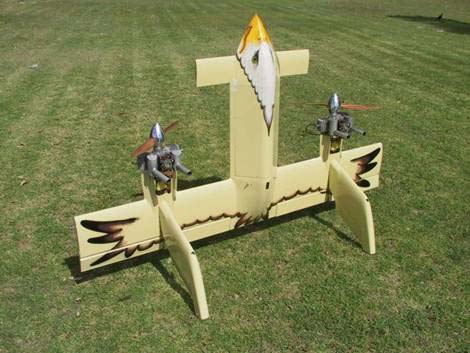

‘I’d
like a plane-helicopter combo, thanks’
Imagine
a vehicle that can take off vertically like a helicopter and then flip
over to fly forward like a conventional plane.
Introducing the T-Wing:
a new unmanned aerial vehicle (UAV) that could provide cheaper and more
efficient surveillance and exploration.
Dr.Hugh Stone, an aeronautical engineer from the University of Sydney,
and his team have been carrying out test flights on the T-Wing.
Dr. Stone began the research as a PhD project and says, “It
can take off and land like a helicopter. It doesn’t need a runway”.

‘Convertiplanes’, such as the T-Wing, that convert
from helicopter to plane mode were developed by combining the strongest
features of both vehicles.
Although helicopters can take off, hover and land vertically, they are
not as efficient at forward flight when compared to a conventional aircraft
and hence do not fly as fast or as far.
“Other UAV convertiplanes use helicopter type propeller blades and
more complex and expensive technology to control the movement of the vehicle.
But the T-Wing uses fixed propellers, like a standard aircraft”
says Stone. The aircraft can change direction and hover using the moving
flaps that sit in the airstream behind the propellers and are controlled
by an onboard computer system.
However, like other similar vehicles, the T-Wing does have its short-comings
too – such as being unstable.
In order to keep the vehicle hovering, the flaps need to move
50 times a second!
So far, the team from the University of Sydney have successfully tested
a prototype that stands at 1.5 metres high with a wingspan of 2.4 metres,
weighing in at 30 kilos.
The tests proved that the aircraft could fly autonomously
(except while landing, when it was assisted from the ground radio control).
The aircraft cannot be flown by radio control from the ground, although
in the case of an emergency, it is possible to communicate with the onboard
computer system.
Want to see how a pane-helicopter combo works? For the original article
and a video of the test flight, click here
(wmv 12MB).
OnSET is an initiative of the Science Communication Program
URL: http://www.onset.unsw.edu.au/ Enquiries: onset@unsw.edu.au
Authorised by: Will Rifkin, Science Communication
Site updated: 7 Febuary, 2006 © UNSW 2006 | Disclaimer
OnSET is an online science magazine, written and produced by students.
![]()
OnSET Issue 6 launches for O-Week 2006!
![]()
Worldwide
Day in Science
University
students from around the world are taking a snapshot
of scientific endeavour.
Sunswift
III
The UNSW Solar Racing Team is embarking
on an exciting new project, to design and build the
most advanced solar car ever built in Australia.
![]()
Outreach
Centre for Sciences
UNSW Science students can visit your school
to present an exciting Science Show or planetarium
session.
![]()
South
Pole Diaries
Follow the daily adventures of UNSW astronomers
at the South Pole and Dome C through these diaries.
News in Science
UNSW is not responsible for the content of
these external sites